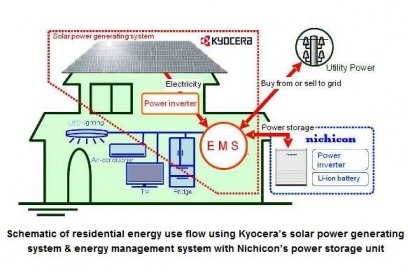
The new system is a direct response to growing demand for residential energy storage equipment following last year’s earthquake and tsunami disasters.
Through its long-term R&D strategy and proprietary technology in solar and energy-related fields, Kyocera has developed an EMS which makes effective use of energy.
Using and regulating a solar power generating system with battery storage requires a power inverter and sophisticated energy-management technology. The EMS developed by Kyocera is thus effective in optimizing residential energy use from those systems and utility power from the electricity grid.
By using Kyocera’s high quality solar power generating systems — which hold the No.2 domestic market share*1 — and Nichicon’s energy storage system which utilizes a lithium-ion battery manufactured by Samsung SDI Co., Ltd., the new energy system is able to more effectively control energy consumption.
“This new system combines the two vital themes of power generation and power storage using Kyocera’s solar power generating system and Nichicon’s energy storage unit,” explained Kyocera President Tetsuo Kuba at a press conference with Nichicon held in Kyoto. “Kyocera will use its energy-management technology to launch this new comprehensive system for optimizing residential energy use, and thus make a real contribution to preventing climate change.”
While striving to realize a low-carbon society through use of renewable energy, and in the wake of the March 2011 disasters, there has been a rapidly increasing need in Japan to address electricity supply instability. This requires implementing energy demand peak-time cuts and peak-time shifts through on-site energy creation and energy storage to stabilize energy demand, as well as the increasingly popular concept of local energy self-sufficiency.
With the restart of the national subsidy program for residential solar power generating systems in January of 2009, and the feed-in tariff program which was also started in November of the same year, it is expected that up through the fiscal year ending 31 March 2012 more than one million homes in Japan will have installed solar power.
Moreover, the Japanese government also agreed on a maximum three-year subsidy program, worth 21 billion yen, for use of stationary lithium-ion battery energy storage systems starting this fiscal year. As this year is the starting point for the subsidies, it is expected that market growth will begin in earnest from here on.
For additional information:

